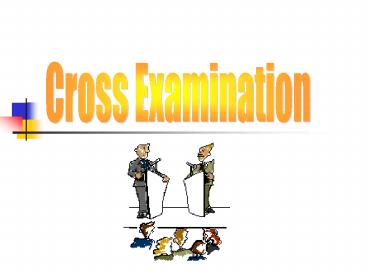Cross Examination - PowerPoint PPT Presentation
1 / 16
Title:
Cross Examination
Description:
What is Cross-examination? The process of questioning the opposing advocate for purposes of clarification and refutation. (Kay and Ziegmueller) Five primary ... – PowerPoint PPT presentation
Number of Views:78
Avg rating:3.0/5.0
Title: Cross Examination
1
Cross Examination
2
What is Cross-examination?
- The process of questioning the opposing advocate
for purposes of clarification and refutation.
(Kay and Ziegmueller)
3
Five primary purposes
- To clarify previous statements of the witness.
- To commit the witness to a particular position on
an issue. - To refute the validity of a previous statement.
- To prepare the way for constructive arguments.
- To undermine the credibility of respondents.
4
Clarify previous statements
- Previous statements given by a witness may be
unclear. - Avoid unnecessary questions of clarification.
- Clarifies definitions of terms.
5
Commit to a position
- The more certain you are of where a witness
stands, the less possibility there will be for a
strategic shift in position later in the debate. - Helps you avoid wasting time on inappropriate
arguments.
6
Refute previous statements
- Most important function of cross-examination.
- Contradictions, irrelevant judgments,
overgeneralizations, inadequate evidence,
incomplete analysisall of these and more can be
revealed through cross-examination.
7
Prepare for constructive arguments
- Using cross-examination will help to establish
the basis for constructive arguments. - Lines of questioning will help in discovering the
arguments the opposition will set forth.
8
Undermine witness credibility
- Used in courts of law the most, however, can be
seen in politics as well. - Can be inappropriate in academic debate.
9
Techniques of the cross-examiner
- Construct basic questions. (avoid random
questions) - Use factual questions. (avoid opinion based
questions) - Use a short series of questions.
- Ex. You have said that there is no significant
relationship between the private ownership of
guns and violence, is that correct?
10
More
- Use analogies and parallel situations.
- Examples One of your arguments is that
marijuana should be legalized because it is
extremely difficult to enforce antimarijuana
laws. Am I right? - Is the purpose of our laws against speeding to
deter drivers from driving too fast?
11
More
- Do not draw conclusions. ( be careful about
going too far with your line of questioning) - Example By your reasoning then, shouldnt we
also legalize speeding and overtime parking and
murder? - This allows the respondent to qualify and explain
his or her answers and makes the
cross-examination less useful.
12
More
- Cut off the witness. (use closed ended
questions) - Drop unproductive questioning. (answers may not
help you) - Use admissions. (follow up on answers in the
witnesses statements) - Develop stock questions. (Use standard
questions)
13
Techniques for Respondents
- Think before answering. (avoid rushing)
- Qualify your answer. (gives the witness an
opportunity provide more relevant information
than was required) - Questioner Isnt true that the number of deaths
from airplane accidents has increased in each of
the last three years?
14
More
- Witness The number of passenger miles flown has
also increased significantly and airplane travel
remains the safest form of transportation. But
yes, there has been some increase in deaths from
air travel. - Placed the answer in a less damaging context.
15
More
- Understand the Question. (seek clarification)
- Provide obvious answers. (short answers)
- Admit ignorance. (avoid bluffing)
- Do not permit questioner conclusions.
(questioner should stick to questions)
16
Conclusion
- Cross-examination differs from direct examination
in that the respondents are less likely to be
friendly to the questioners cause. - In cross-examination the questioner takes
control. - A respondent should remain calm, competent, and
in control.































